George Edward (Spike) Donnelly
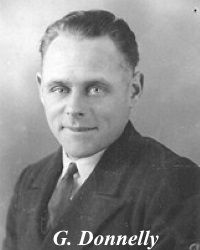
Place of birth: Portsmouth, England
Wife: Mollie Donnelly
Previous occupation: Bricklayer
Service: Royal Navy
Rank: Stoker
Service Number: P/KX88065
Joined Hood: 8th September 1936 (Stoker 2nd Class)
Left Hood: 6th November 1938 (Stoker 1st Class)
Biographical Information:
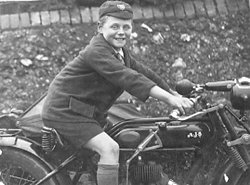 On May 31st 1917, I was born in Portsmouth, England in Lion Terrace, just opposite the "Stone Frigate" "H.M.S. Victory" now "H.M.S. Nelson" in a building that was then a military hospital. Being born so close to naval surroundings, I was destined to become a sailor.
On May 31st 1917, I was born in Portsmouth, England in Lion Terrace, just opposite the "Stone Frigate" "H.M.S. Victory" now "H.M.S. Nelson" in a building that was then a military hospital. Being born so close to naval surroundings, I was destined to become a sailor.
When I was 5 years old my parents sent me on a visit to "H.M.S. Victory" which then was still a commissioned ship in the waters of Portsmouth Harbour. Many years after, when serving in "H.M.S. Hood" I could see the Victory in dry dock from our mooring in Pitch House Jetty.
After leaving High School "Form 4" at Cowplain, I served an apprenticeship as a Bricklayer also worked as a part time soldier in the Royal Engineers Territorial Army as a Searchlight Operator.
In January, 1936, 1 applied to join the Royal Navy and started training in February for a period of 12 years at sea. The first 8 weeks in the navy consisted of Field Training, Gymnastic, Rifle Drill and Swimming Instructions. Then on to Mechanical Training for Stoker Ratings including a week at sea in a Destroyer "H.M.S. Winchester". That part I enjoyed very much. After training I was given work around the barracks and finally my first draft notice arrived.
George (back row, left) at H.M.S. Benbow.
I was to join "H.M.S. Hood" in September and serve my first 2 years in the Mediterranean Fleet.
The primary job of our ship was non-intervention patrols during the Spanish civil war. At times we were met by friendly ships like the "U.S.S. Raleigh" a cruiser and two
destroyers, the "U.S.S. Kane" and "Hatfield" while on the other hand, the not so friendly "Graf Spee" and "Deutschland" of Germany who were favouring Franco's civil war.
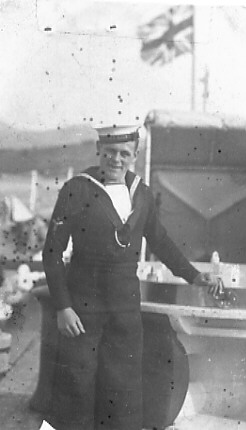 Having read Nutty Turner's account of our commission in the Mediterranean, my account would be the same. So I will mention my parts of ship not forgetting to mention cleaning out our condensers after going over a sandbank filling them with sand. Then my parts of ship varied, No I boiler room under a very capable, The late Chief Stoker Styles, who was a very strict but kind person, and then after a few months it was on to turbo Dynamo's, Co. 2 machinery for making ice, Hydraulics' for operating the main armament, picket boats boiler operator, under The Late Stoker Petty Officer Binnie, (a fine person) and finally on evaporators, for making fresh water, where Lt. Kemp was my officer in charge and Lt. Lee Bailey my divisional officer. One day I informed Lt. Kemp that I had made a request to be transferred to the new fleet air arm and had been accepted and he said, "so have I." Later when in Marseilles, France, we who had been accepted for the fleet air arm left the ship and proceeded overland by train to Dieppe then by sea to Portsmouth.
Having read Nutty Turner's account of our commission in the Mediterranean, my account would be the same. So I will mention my parts of ship not forgetting to mention cleaning out our condensers after going over a sandbank filling them with sand. Then my parts of ship varied, No I boiler room under a very capable, The late Chief Stoker Styles, who was a very strict but kind person, and then after a few months it was on to turbo Dynamo's, Co. 2 machinery for making ice, Hydraulics' for operating the main armament, picket boats boiler operator, under The Late Stoker Petty Officer Binnie, (a fine person) and finally on evaporators, for making fresh water, where Lt. Kemp was my officer in charge and Lt. Lee Bailey my divisional officer. One day I informed Lt. Kemp that I had made a request to be transferred to the new fleet air arm and had been accepted and he said, "so have I." Later when in Marseilles, France, we who had been accepted for the fleet air arm left the ship and proceeded overland by train to Dieppe then by sea to Portsmouth.
After leave I was sent to Whale Island to tend boilers while awaiting a call to report to the Royal Air Force.
The engineering course with the RAE required much of our leisure hours for study unlike leisure hours in the Hood where I did study engineering, played a lot of darts, a member of a rifle team, Stokers Cutter Crew.
With several other ratings I was drafted to Henlow in Bedfordshire for 3 months learning to file and construct test items in metal. We were then drafted to the school of then training RAF at Locking Weston Super Mare for a further 6.5 months or air engineering training.
On September 3rd 1939, all leave was stopped and our course shortened by 2 months. Our final job with the RAF was to assemble three dozen Hawker Fury single seated fighters to back up the Squadrons of Spitfires and Hurricanes if required.
The naval classes were paraded and given our future assignment to ships or air stations. My draft was to a Walrus squadron stationed at "H.M.S. Peregrine", an air station at Ford in Sussex.
I was delighted with the draft because amphibian Walrus aircraft were used on cruisers and battle cruisers and I saw sea time ahead, but when I reported to the squadron I found we were training pilots, observers & air gunners and standby air sea reserve service, being so close to the English Channel.
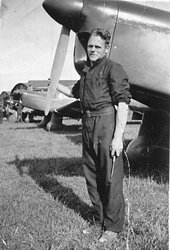 The last few weeks of 1939 and the first months of 1940 were spent on routine flying training. As early spring arrived, air raid warnings were frequent as hostile aircraft were often near us and made us aware that the funny war was over. In 1940 I was recommended to take a C W course to become an officer but could not complete the course after several weeks as we were constantly at action stations of the air raids. The great withdrawal of thousands of troops from Dunkirk was over. Ken Pitter, Stoker PO, a former Hood shipmate died at Dunkirk. We, air mechanics, underwent training in infantry by sergeants of the Brigardy guards to enable us to fight off Paratroopers. I was lucky as I had an old Ross rifle and 5 rounds of ammo. Some had grenades. As the battle of the Britain heated up, our aircraft, between raids, flew out over the channel water to pick up survivors - both ours and theirs. In action on Sunday, Aug. 18 we were dived bombed by Stuka's leaving 80 casualties (30 killed & 50 wounded). We were sent on leave for 10 days. We would service our aircraft between raids then get into machine gun pits at action stations. Towards the end of September sneak raids were often.
The last few weeks of 1939 and the first months of 1940 were spent on routine flying training. As early spring arrived, air raid warnings were frequent as hostile aircraft were often near us and made us aware that the funny war was over. In 1940 I was recommended to take a C W course to become an officer but could not complete the course after several weeks as we were constantly at action stations of the air raids. The great withdrawal of thousands of troops from Dunkirk was over. Ken Pitter, Stoker PO, a former Hood shipmate died at Dunkirk. We, air mechanics, underwent training in infantry by sergeants of the Brigardy guards to enable us to fight off Paratroopers. I was lucky as I had an old Ross rifle and 5 rounds of ammo. Some had grenades. As the battle of the Britain heated up, our aircraft, between raids, flew out over the channel water to pick up survivors - both ours and theirs. In action on Sunday, Aug. 18 we were dived bombed by Stuka's leaving 80 casualties (30 killed & 50 wounded). We were sent on leave for 10 days. We would service our aircraft between raids then get into machine gun pits at action stations. Towards the end of September sneak raids were often.
In October, like many others, our Squadrons were relieved by RAF 23 Squadron Night Fighters of the Royal Air Force.
Our movement was secret but in the middle of one night all three squadrons were entrained and we travelled to Liverpool and embarked in a liner, "The Avila Star" and put to sea the next day. Before we reached the open sea we were hit by another ship and damaged enough to make us return for repairs. While back in Liverpool I met a former shipmate, Stoker Reading ex-Hood. After 10 days we were at sea again and joined a convoy of 5 ships with a 2 destroyer escort. We steamed out into mid Atlantic and we, in darkness, left the convoy and started south. The rest of the convoy carried on west to Canada & America. We heard at a later date, that convoy was carrying children to Canada.
On our journey south, it was alarming and sad to see the remains of ships torpedoed by U boats. We were very lucky.
We sighted land, which turned out to be Trinidad, and we entered Port of Spain and found the aircraft of our 3 squadrons had arrived before us.
Our living quarters were on the edge of an orange plantation and named "H.M.S. Goshawk". Our aircraft were assembled and parked on the airfield "Piarco".
Although it was peaceful here, we all were very worried and concerned by the news from home (late 1940-4 1). Always thinking of our loved ones and the blitz they were going through, however, we had a job to do toward the final result of winning a war.
As Piarco airfield was being enlarged, construction was going on all the time and one sad incident I witnessed was a native being bitten by a bushmaster snake. He died in 10 minutes. There was no antidote for that snake poison.
I was promoted to Leading Air Mechanic and put in charge of 3 Walrus Aircraft including the Riggers Fitters. My promotion was to replace an R.A.F. Corporal. My flight was now made semi- operational over and above our regular training routine. Our planes were always fully loaded with death charges and loaded machine guns in case we were called on to locate and destroy U Boats. Training was at its full height in the month of May and on the 24th we were shocked by the news of the loss of "H.M.S. Hood" and her fine crew. Many of them I knew. I personally mourned her loss for days after as did many of my present shipmates.
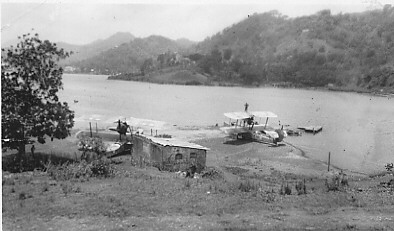 Early in June I was sent for and told that my flight of aircraft was now part of a new squadron to be known as 749 Squadron and that I was to fly on the next day as an air gunner and maintenance. We were to fly to destination X. After flying over Tobago, Grenada, St. Vincent we finally dropped down in the Harbour of Casteries at St. Lucia. My first job was to refuel the aircraft from 50 gallon drums by hand pump and from a rowboat moored from the A/C. Not an easy job believe me.
Early in June I was sent for and told that my flight of aircraft was now part of a new squadron to be known as 749 Squadron and that I was to fly on the next day as an air gunner and maintenance. We were to fly to destination X. After flying over Tobago, Grenada, St. Vincent we finally dropped down in the Harbour of Casteries at St. Lucia. My first job was to refuel the aircraft from 50 gallon drums by hand pump and from a rowboat moored from the A/C. Not an easy job believe me.
My orders now were to instruct local police officers how to guard the aircraft and keep the bilge pumped out as water could leak into the craft if left for many hours. I proceeded ashore to find that the Commanding Officer had made billet arrangements for us ratings and the officers.
Our flying orders for the next day was to do a reconnaissance flight over the island of Martinique then held by the Vichy French but controlled by the Germans. Valuable information & photographs were made and no shots or anti aircraft missiles were fired at us as we had expected. On our return to St. Lucia I refuelled and stood by for further orders for a second mission - but orders changed.
Early next morning the Commanding Officer and navigator arrived with 3 other officers (1 British Brigadier and 2 French Cornells) with baggage. We were to return to Trinidad with these offices and baggage. I told the C/O I would stand down and he said no and I explained that the aircraft would be overloaded. I stored the baggage and settled these officers down. I took the rear gun position and after 3 attempts we were airborne and enroute to Trinidad where we landed safely.
Three or four weeks passed and our usual routine of air patrols and training carried on. Senior position Chiefs & POs being in short supply created more responsibility placed on my shoulders. Being sent for again - this time by the ship's commanding officer, my C/O. and the Master at Arms, my orders this time were to be very secret. They were destination X.
1. Select your best maintenance crew of 4. (1 engine mechanic, 1 rigger, 1 armourer, and 1 electrical mechanic).
2. Report to the clothing store to be fitted up with civilian clothes.
3. We were isolated from the ship's company.
Late at night we were transported to the Port of Spain and embarked in "H.M.S. Caradoc", a cruiser. We were not allowed to see or even speak to any crew members. Dressed in plain clothes, they did not even know we were navy men. The cruiser put to sea and a day later we entered the Harbour at Casteries, St Lucia. We were disembarked and the first thing 1 had noticed was that my flight of 3 aircraft was there moored on the water. The "Caradoc" left and we took over the charge of our aircraft. The Commanding Officer & I contacted the local department of works to help select a secluded spot where we could beach our aircraft for regular maintenance. A site within the local asylum was chosen and a slipway constructed by local labour to run our planes out of the water. Junior Ratings were billeted in a local hotel, the officers in Government House.
Daily flights were now routine over Martinique and anti U Boat patrols as this part of the West Indies was a real hunting ground for U Boats as they were taking a heavy toll on shipping from both United States and British.
One amusing incident occurred one day when we landed in the harbour. Present at anchor was an armed merchant cruiser "H.M.C.S. Prince Henry". We taxied over the water and tied up astern of the ship. I was first up the rope ladder followed by the telegraphist, the navigator and the skipper. All in flying gear after saluting the QD and permission to be aboard, we stood in file to be greeted by the Captain. He invited us to the wardroom for refreshment. Our skipper coughed discretely and explained that two of the A/L crew are ratings, the officer went to the wardroom. We were entertained by the Ch POs mess. On regular visits after that meeting the "Prince Henry" kept us with some of our supplies that were scarce like rum and cigarettes.
With the serious duty that we were on and on an island where you do not know friend from foe and you have no contact with home as letters were not permitted, a visit by a friendly warship was welcome with news from home. HMS dispatch called in on one occasion but we kept under cover for security reasons. In my billet one day looking out the window I observed a group of sailors on shore leave and amongst them I observed several men who had served in "H.M.S. Hood" with me. One man especially. His name was Stoker Happy Day - but contact was impossible.
Our daily routine was interrupted one day with my engine mechanic reporting to me that he had found a small gouge in the plane air propeller. I examined it and decided it was unsafe to fly the aircraft like this. I reported to the Commanding Officer. He questioned my findings and the aircraft flew. Three hours later I received a message from a coast watcher saying the he could see distress signals from an aircraft on the water between St. Lucia and Martinique. We acquired a fast motor boat and proceeded to sea to retrieve the aircraft. The sea was choppy so getting a line to the aircraft was difficult. Swimming was out of the question because of sharks and barracuda. Eventually we got a line on board and towed the plane back to Castariers. The damage that the shattered aircrew had caused was extensive. Broken ribs in the wings, the trailing edge of both upper wings ceased to exist, the engine completely encrusted with salt. We bad to beach the aircraft and to effect any repairs was awkward without a crane. Other means had to be used to lift the plane a shore.
In contact with the department of work and the local jail, 50 convicts from the local jail lifted the aircraft out of the water. We could now lower the under carriage by hand with the aircraft on the beach.
Our other two aircraft were recalled for more extensive duties in Trinidad so my crew of mechanics and I were left on our own and to make matters worse our Commanding Officer was taken ill with malaria and confined to hospital. I had to report to him daily. Our repair work was going to take several weeks. With limited supplies the work consisted of a partial dismantling of the engine which had to be washed and scrapped clear of salt. Several ribs had to be repaired or patched. We had to fashion & fit two trailing edges to the wings, recover with fabric. No Irish linen or dope was available to cover the damaged wings so we had to use an old bed sheet and stiffen it up with nail varnish.
A flying fortress of the U.S. Army Air Force flew in a new air screw for us. Our work now complete we started up the engine. A new pilot was sent out from Trinidad and we air tested the aircraft. It proved to me that the RAF had trained us former seamen stokers really well.
Our whole unit now returned to Trinidad and we found that our various aircraft were being replaced with twin engine Grumman Geese from America. I flew on several test flights then my turn came to return to England. I was placed in charge of 15 ratings who had been trained as observers and on return to England they were to be commissioned as sub officers.
My draft and I embarked in an American troopship and before we sailed the ship's captain sent for the leader of our draft. I reported, he was very concerned about anti/sub & aircraft lookouts. He said "would you organise your men into lookout as you British are very experienced". I was happy to agree. When I told my charges what we were going to do they strongly objected and said we are going to be officers, you cannot tell us what to do. I said "Try me, if you don't obey my orders you will never be officers but charged with refusal to obey an order and mutiny on the high seas in war time". They decided that I held the authority and decided to co-operate this troopship. The "Evangaline" was returning to the USA with many troops and many women. Our first port of call was to be Havana in Cuba, but U Boat activities caused us to be diverted to Panama where we stayed for several days. My draft was continuing to keep watch for hostile aircraft from Japan. On the first day in Panama City an American cruiser was towed in badly damaged in Pearl Harbour. It was the "USS Raleigh", the Hood's chummy ship in the Mediterranean 1936-38. Our orders now I understand were to proceed to San Diego USA but when at sea we were ordered to return to the Panama Canal and make for Tampa Florida by joining a convoy at Colon, the canal eastern entrance.
On arrival at Tampa we were placed on a troop train for New York. We were stopped on the rail station at Washington DC and looking out of the train window I noticed a big placard say only two shades of nylons are available for ladies and in small print the Ladies of England fight fires. On arrival in New York, we embarked on another troopship. My crew was again U Boat & aircraft lookouts.
The ship was the Duchess of Bedford and Canadian owned. We had 3000 American troops on board. Many of them WW1 veterans returning to England to fight in WW2. When talking to us they said "last time we were going to a shooting gallery but not this time. This is a real war".
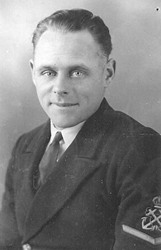 As we sailed it was a terrible sight to se the French Liner Normandy lying on its side in the Dock opposite us. We steamed north in convoy to Bedford Bay, Halifax, Canada where we became part of a very large convoy bound for England. This large group sailed in darkness north toward the Arctic and then proceeded, in fierce fog for 3 or 4 days, east towards England. When the fog cleared we came under attack by U Boats and Condor aircraft. The convoy reached Liverpool with little loss. We entrained and finally arrived at "H.M.S. Daedelus" Lee on Solent. I was relieved of my draft and sent on a month's leave. My home was only 18 miles away and after being there to have a good meal and a reunion with parents a telegram came recalling me for the next day at 6:00 a.m.. The next morning I boarded a bus for Portsmouth and found the Highway all the way to Portsmouth was packed with army transport and ambulances. This was the day the Canadians went to Dieppe and my job was to be in standby beach party receiving wounded coming back. I was also promoted to Petty Officer that day. Before returning home to have my leave I visited the Canteen and met a beautiful Irish girl. 6 months later we were married and spent the next 46 years together. She died in l987. We had one son. On my return from leave I was sent on a nine month course of mechanical training and disciplinary subjects. Completing the course I was assigned to aircraft storage unit to await draft.
As we sailed it was a terrible sight to se the French Liner Normandy lying on its side in the Dock opposite us. We steamed north in convoy to Bedford Bay, Halifax, Canada where we became part of a very large convoy bound for England. This large group sailed in darkness north toward the Arctic and then proceeded, in fierce fog for 3 or 4 days, east towards England. When the fog cleared we came under attack by U Boats and Condor aircraft. The convoy reached Liverpool with little loss. We entrained and finally arrived at "H.M.S. Daedelus" Lee on Solent. I was relieved of my draft and sent on a month's leave. My home was only 18 miles away and after being there to have a good meal and a reunion with parents a telegram came recalling me for the next day at 6:00 a.m.. The next morning I boarded a bus for Portsmouth and found the Highway all the way to Portsmouth was packed with army transport and ambulances. This was the day the Canadians went to Dieppe and my job was to be in standby beach party receiving wounded coming back. I was also promoted to Petty Officer that day. Before returning home to have my leave I visited the Canteen and met a beautiful Irish girl. 6 months later we were married and spent the next 46 years together. She died in l987. We had one son. On my return from leave I was sent on a nine month course of mechanical training and disciplinary subjects. Completing the course I was assigned to aircraft storage unit to await draft.
This draft came as a complete surprise. I was expecting a seatime draft, but not so, my draft was to "H.M.S. Fledgling" as an instructor to probationary wrens wanting to be air mechanics. After 1 year and IQ courses of wrens I was ready to be drafted but again not so. During my last class of wrens an Officer of the Royal Canadian Navy came into my classroom. In his words "Chief Donnelly, you now belong to my staff to train Canadian sailors as air mechanics. I had 12 classes of them They were great fellows. At the close of their training our establishment was visited by an officer had worked for on the "H.M.S. Hood" Admiral Kemp. He knew me right away. Also on our training staff was Chief Dubber who also served on Hood with us. Our reunion was a very sad one as we remembered so many of our good friends & shipmates that perished with H.M.S. Hood. The war was now over and I was returned to "H.M.S. Daedelus" for reassignment.
The navy was now looking for anyone with any trade experience to teach men leaving the service with one skill or another. Having been a bricklayer, I volunteered and was accepted. My idea was twofold (1) teaching my trade and (2) polishing up my skills as I intended leaving the navy after 12 years. I was transferred to "H.M.S. Flycatcher" for a while, then on to "H.M.S. Caballo". I was drafted back to Daedelus in Sept. 1947 and discharged in Feb. 1948 and went straight back to my trade. Being employed by Portsmouth Dockyard Building Dept. I was further employed by two building companies in Portsmouth, I then immigrated to Canada with my wife, son and with my building experience, my air mechanics trade certificate, my aux watchkeeping certificate, I have never been out of work in Canada.
My work in Canada has been varied such as building construction, assembling aircraft, stationary engineering, atomic research and my last job was in charge of engineering maintenance in a large factory. When I retired in 1980, my wife and I spent our winters in Florida, U.S.A. and during these winters we were able to entertain 2 former shipmates or "H.M.S. Hood" in the persons of Commander Woolton, the dentist, 1936-1938 and Nobby Clark, 1937-1939. I lost my first wife in 1987 and for 2 years I was on my own until I met a fine & lovely Canadian lady whom I fell in love with on first sight. Shirley and I have been married for 12 years and are both very happy. I have 2 grandsons and several step grandchildren. One young lady is teaching in Korea. I have several interests and have had some volunteer items.
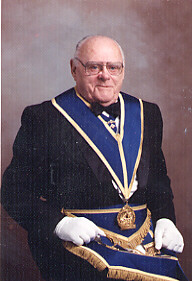 They are:
They are:
- Supporter of Canadian Sea Cadets, Unit 34 "Hood",
- Sea Scout Master of Sea Scout ship "Victory"
- Meals on Wheels for elderly seniors
- Served on the Committee for the construction of a naval war memorial.
- Rewarded by being proclaimed "Senior Citizen of Oakville" 1989.
I am 85 years old and looking forward to the future with our ship's motto "Ventis Secundis".
George E. Donnelly, 2001
History of ships served in and ratings held:
| Date From | Date to | Ship | Rating | Source |
| 4th February 1936 | 7th September 1936 | Victory | Stoker 2nd Class | Service record (via George) |
| 8th September 1936 | 2nd November 1936 | Hood | Stoker 2nd Class | Service record (via George) |
| 3rd November 1936 | 6th November 1938 | Hood | Stoker 1st Class | Service record (via George) |
| 7th November 1938 | 30th September 1939 | Victory | Stoker 1st Class | Service record (via George) |
| 1st October 1939 | 18th October 1939 | Daedalus | Stoker 1st Class | Service record (via George) |
| 19th October 1939 | 19th October 1939 | Daedalus | Air Mechanic | Service record (via George) |
| 20th October 1939 | 31st March 1940 | Peregrine | Air Mechanic | Service record (via George) |
| 1st April 1940 | 30th September 1940 | Peregrine | Air Mechanic 1st Class | Service record (via George) |
| 1st October 1940 | 2nd November 1940 | Daedalus | Air Mechanic 1st Class | Service record (via George) |
| 3rd November 1940 | 5th November 1940 | Daedalus | Acting Leading Air Mechanic | Service record (via George) |
| 6th November 1940 | 2nd November 1941 | Goshawk | Acting Leading Air Mechanic | Service record (via George) |
| 3rd November 1941 | 28th February 1942 | Goshawk | Leading Air Mechanic | Service record (via George) |
| 1st March 1942 | 11th June 1942 | Goshawk | Acting Petty Officer Air Mechanic | Service record (via George) |
| 12th June 1942 | 3rd January 1943 | Daedalus | Acting Petty Officer Air Mechanic | Service record (via George) |
| 4th January 1943 | 16th January 1943 | Excellent | Acting Petty Officer Air Mechanic | Service record (via George) |
| 17th January 1943 | 19th April 1943 | Daedalus | Acting Petty Officer Air Mechanic | Service record (via George) |
| 20th April 1943 | 9th June 1943 | Fledgling | Acting Petty Officer Air Mechanic | Service record (via George) |
| 10th June 1943 | 28th February 1945 | Fledgling | Petty Officer Air Mechanic | Service record (via George) |
| 1st March 1945 | 18th November 1945 | Fledgling | Chief Petty Officer Air Mechanic | Service record (via George) |
| 19th November 1945 | 21st November 1945 | Daedalus | Chief Petty Officer Air Mechanic | Service record (via George) |
| 22nd November 1945 | 23rd March 1946 | Flycatcher | Chief Petty Officer Air Mechanic | Service record (via George) |
| 24th March 1946 | 27th September 1946 | Dipper | Chief Petty Officer Air Mechanic | Service record (via George) |
| 28th September 1946 | 10th October 1947 | Cabbalu | Chief Petty Officer Air Mechanic | Service record (via George) |
| 11th October 1947 | 8th April 1948 | Daedalus | Chief Petty Officer Air Mechanic | Service record (via George) |
| 9th April 1948 | Discharged | Chief Petty Officer Air Mechanic | Service record (via George) |
Additional Photographs
None at this time.
No known memorials
Sources
Commonwealth War Graves Commission
'Register of Deaths of Naval Ratings' (data extracted by Director of Naval Personnel (Disclosure Cell), Navy Command HQ, 2009)
